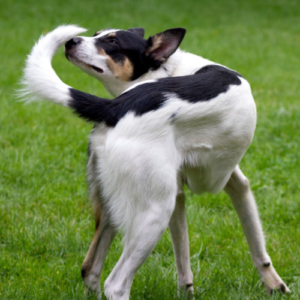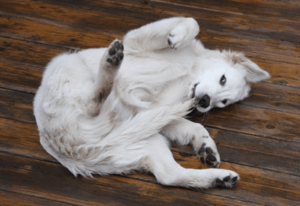 Why Do Dogs Chase Their Tails?
Why Do Dogs Chase Their Tails?
Your dog chasing his tails on different occasions is normal. Whether you are taking a walk with him in the park or you are inside your living room, chances of seeing your dog chase his tail are pretty high. As a dog owner, you may want to know what specifically causes this peculiar behavior. Sometimes your dog will chase his tail in response to a seemingly exciting event and in other times, it can look more like an endless cyclone as the dog chases his tail over and over until he finds a new distraction. There’s a vast range of reasons why dogs chase their tails and the reason why your dog chases his tail might be different from that of your neighbor’s dog. To help you have a clearer understanding of why dogs chase their tails.
Let’s take a look at some of the most common reasons why dogs chase their tails.
6 Main Reasons Why Dogs Chase Their Tails
-
Boredom
One major reason why your dog is often chasing his tail on different occasions could be because he is bored and lacks mental stimulation. Your dog will therefore chase his tail as he tries to simply burn out the excess energy or seek your attention to play with him. That’s the case for most dogs especially puppies. In most cases, these dogs will run around in circles to keep themselves occupied. For puppies who haven’t recognized the tail as part of their body, it even becomes more fun for them. They will see a fuzzy object in their periphery and assume that’s it is another animal trying to attack them. The puppy will then run in circles as he tries to get hold of their tail.
Related Post: Best Tennis Ball Machines for Dogs
-
Medical Condition
If you see the dog chasing his tail on occasions, that’s perfectly normal. What’s not normal and should be a reason of concern is if you notice that the behavior is constant. If you have a dog that constantly chases his tail, it could be a signal for more serious health issues. Obsessive chasing of the tail could be caused by brain abnormality related to the seizure-like activity. In some cases, obsessive tail chasing is considered a symptom of canine compulsive disorder. Other reasons could be a painful area where the tail was docked on an infection around the tail area. If left unchecked, obsessive tail chasing can become destructive and end up causing dogs to damage their tails.
-
Puppy Playfulness
Just like human kids, puppies love playing and also love to discover more about their world with their mouths. So, your puppy will play and chase their tail around because they are yet to discover themselves. As they grow, they learn new things about themselves. Furthermore, puppies are incredibly playful and they are likely to see their tail as the only toy to play with. Your puppy will outgrow that behavior once he gets old and realizes that the tail is one part of his body.
Related Post: Best Puppy Harness
-
Flea Infestation
The other possible reason why dogs chase their tails could be that they are infested by fleas. If that’s the case, your dog’s tail becomes itchy and he will chase his tail to try and bite it to relieve that itchiness and pain. While dogs are most likely to sit down as he tries to reach an itchy spot in any part of his body, they will try chasing their tail at first. If you notice that your dog is trying to chew on their tail, you’ll want to check for fleas and other parasites infestation.
See Also: How to Remove a Tick From A Dog
-
Attention Seeking
Your dog will try to gain your attention by chasing his tail. If your dog feels like you are not giving him enough attention, he is going to try working out different behaviors then see which one works out. Your dog, any attention is better than none and he will always chase his tail around you as he tries to gain your attention. Our canine friends are sociable creatures who enjoy play and interaction. It is therefore important that you set aside some quality time each day to play and interact with your dog.
-
Anxiety
Another reason why dogs chase their tails is anxiety. Repetitive behaviors such as tail chasing can be a source of comfort and relief to your dog and it serves them as a stress reliever, he is going to start doing it whenever he feels anxious. Some typical causes of dog anxiety include separation anxiety, lack of opportunity to socialize, complex social interaction with another pet, small living areas, and fear of new experiences as well. If you suspect that your dog’s tail-chasing behavior is a result of anxiety-related compulsion, seek veterinarian advice on how to help your dog.
See Also: Best Dog Crates for Separation Anxiety
 What to Do About Dogs Chasing Their Tails
What to Do About Dogs Chasing Their Tails
Treating compulsive behaviors such as dogs chasing their tails can be difficult because compulsions often result from both learned behavior and imbalances in the brain. If your dog is always chasing his tail here is what you can do to help him change that behavior.
-
Identify and Remove the Problem
Constant tail chasing can be a symptom of dog anxiety. Identify the stressful things or situations that seem to trigger your dog’s compulsive behavior. If you are successful in removing those triggers, you will be able to greatly remove the stress levels. Of course, it is always not possible to get rid of the thing/situation completely. For example, if your dog is always anxious about thunderstorms, there is no way for you to stop them from happening. You will therefore have to do some training to make the dog feel less anxious.
-
Distract and Redirect Your Dog’s Attention
Your dog might be chasing his tail because he is bored. As soon as he starts to engage in chasing his tail, distract him. Give him something to keep himself occupied. You can either give him toys to play with. You can also give him a food-filled puzzle toy stuffed with peanut butter. The other thing you can do is to tell him to perform a previously learned behavior or trick which he can’t do simultaneously with the compulsive behavior. When he starts to spin or chase his tail, ask him to sit or lie down. Sometimes, this is enough to stop the compulsive behavior before it even begins.
-
Create Time to Play with Your Dog
Exercising your dog’s mind and body will greatly enrich his health and life and it does to you. Providing your dog with lots of physical and mental stimulation will help him lower down the stress levels and provide an appropriate outlet for normal dog behavior. Moreover, a physically and mentally tired doesn’t have much energy to engage in any compulsive behavior.
To keep your favorite canine friend happy and occupied, try the following tricks.
- Provide your dog with at least 30 minutes of vigorous exercises every day and at any time he encounters stressful situations. This will help him relax and remain calm.
- Play interactive and fun games with him such as fetch and tug of war. By playing with him, your dog won’t have to chase his tail as he seeks to gain your attention.
- Take your dog for outdoor walks in different parks and routes as much as possible. By doing so, your dog experiences new smells and sights as well.
- If your dog loves to play around with other dogs, let him do that.
- Provide your dog with toys to keep him occupied while indoors. With food puzzle toys, you can feed your dog his meals in these toys or stuff them with a little peanut butter or cheese. You can also provide him with edible and inedible chew things, especially during stressful times.
- When it’s feeding time for your dog, hide small piles of his kibble around the house and make him hunt for them. Most dogs love this game as it makes them exercise their bodies and muscles.
FAQs About Why Dogs Chase Their Tails
Q: Is tail-chasing good for dogs?
A: If you see the dog chasing his tail on occasions, that’s perfectly normal. By nature all dogs are playful and it is common for them to chase their tails. What’s not normal and should be a reason of concern is if you notice that the behavior is constant. If the behavior is left unchecked, your dog can end up being self-destructive and damage his tail.
Q: Why do dogs chase their tails?
A: There are several reasons why you see your dog chasing his tail. In many cases, dogs chase their tails because of excessive energy, boredom, attention-seeking, or because their tails are infested by fleas.
Q: Is it normal for puppies to chase their tails?
A: Yes, it is. With puppies being so much playful, it is perfectly normal for puppies to chase their tails. Some puppies aren’t aware that the tail a part of their bodies. They will think that it’s a toy and end up trying to chase it around.
Conclusion
Constant tail chasing in older dogs can be a sign of a behavioral problem. Your dog might have developed a compulsive behavior disorder that makes them chase his tail for no apparent reason. If you notice an older dog chasing its tail often, seek help from your vet.
Related Post: Best Flea Treatment for Dogs
